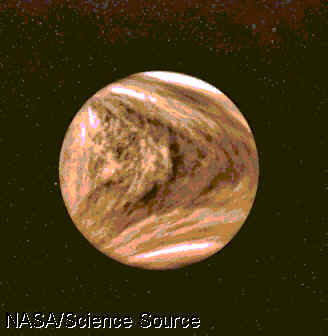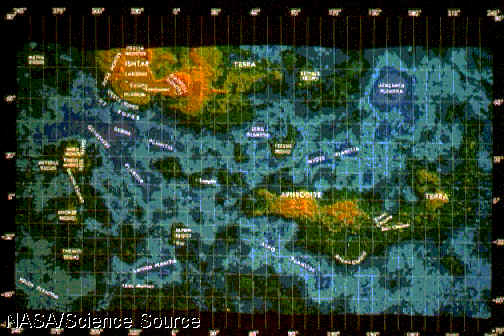|
|
|

Exploration
Venus's complete cloud cover and deep atmosphere make it difficult to study from earth, and most knowledge of the planet has been obtained through the use of space vehicles, particularly those carrying probes that descend through the atmosphere. The first flyby was that of Mariner 2, launched by the United States in 1962, followed by Mariner 5 in 1967 and Mariner 10 in 1974. The Soviet Union has developed several entry probes, some combined with flybys or orbiters: Veņera 4 and 5 (1967), 6 (1969), 7 (1970), 8 (1972), 9 and 10 (1975), 11 and 12 (1978), 13 and 14 (1981), and 15 and 16 (1983); Vega 1 and 2, sent toward Halley's comet in 1984, also flew by Venus and released descent capsules. Several of these probes successfully reached the planet's surface. The U.S. sent two Pioneer Venus missions in 1978. Pioneer Venus 2 sent four probes to the surface, while the remaining craft explored the upper atmosphere. Pioneer Venus 1, an orbiter, continues to measure the upper atmosphere. The Magellan probe, launched toward Venus in 1989, began transmitting radar images of the planet in 1990.

*(topography of Venus)*
Atmosphere
The surface temperature on Venus is highly uniform and is about 462° C (736 K/864° F); the surface pressure is 96 bars (compared with 1 bar for earth); the atmosphere of the planet consists of nearly all carbon dioxide (CO2). The cloud base is at 50 km (31 mi), and the cloud particles are mostly concentrated sulfuric acid. The planet has no detectable magnetic field.
That 97 percent of Venus's atmosphere is CO2 is not as strange as it might seem; in fact, the crust of earth contains almost as much in the form of limestone. About 3 percent of the Venusian atmosphere is nitrogen gas (N2). By contrast, 78 percent of earth's atmosphere is nitrogen. Water and water vapor are extremely rare on Venus. Many scientists argue that Venus, being closer to the sun, was subjected to a so-called runaway greenhouse effect, which caused any oceans to evaporate into the atmosphere. The hydrogen atoms of the water molecules could have been lost to space and the oxygen atoms to the crust. Another possibility is that Venus had very little water to begin with.
Surface Features
Venus rotates very slowly on its axis, and the direction is retrograde (opposite to that of earth). Curiously, Venus's synodic year is almost exactly five solar days long, with the result that the same side always faces earth when the two planets are closest. At such times, the side facing earth can be viewed and mapped by earth-based radio telescopes.

For more information on Venus, Please visit the following webistes:

[Hit Counter]
